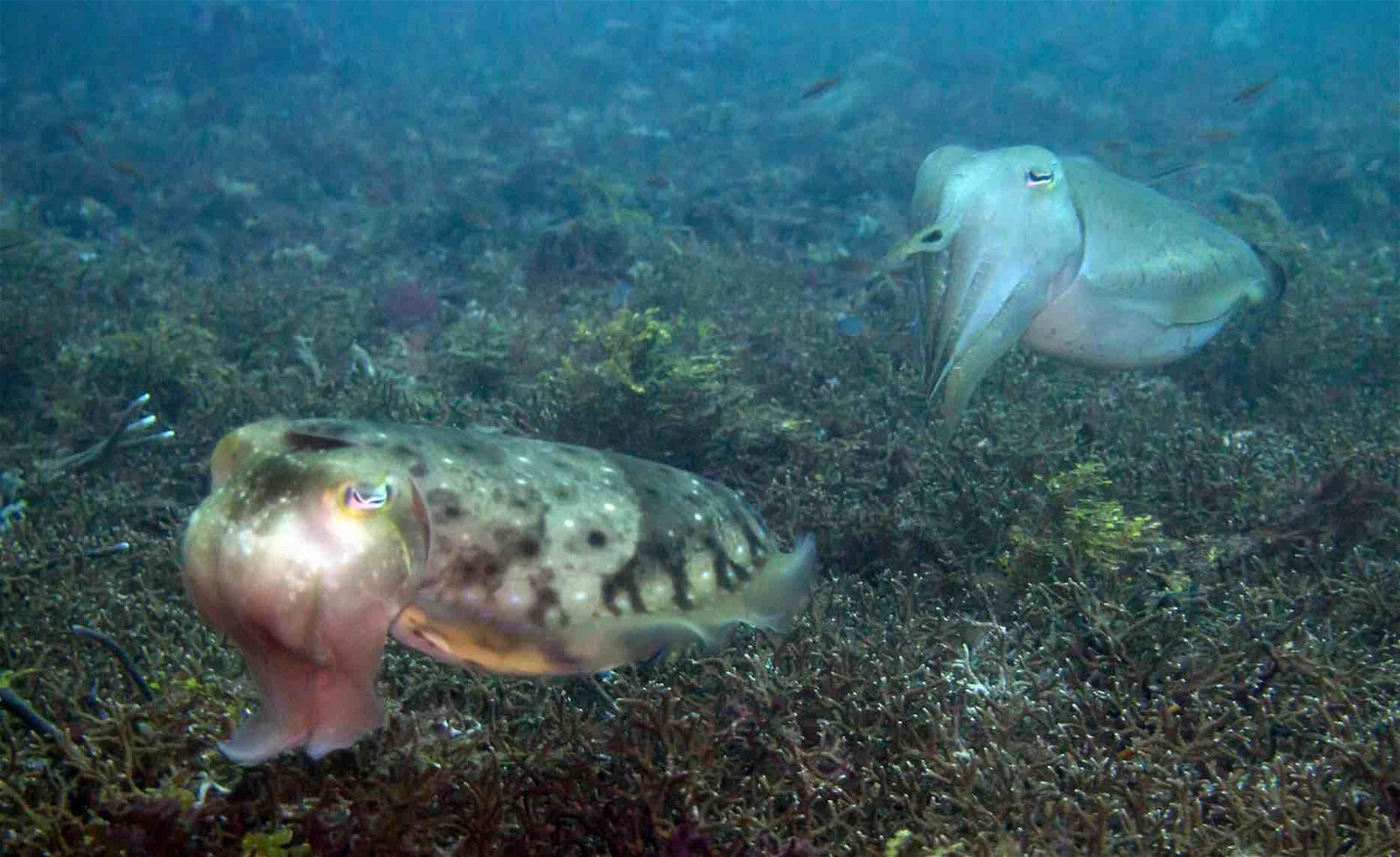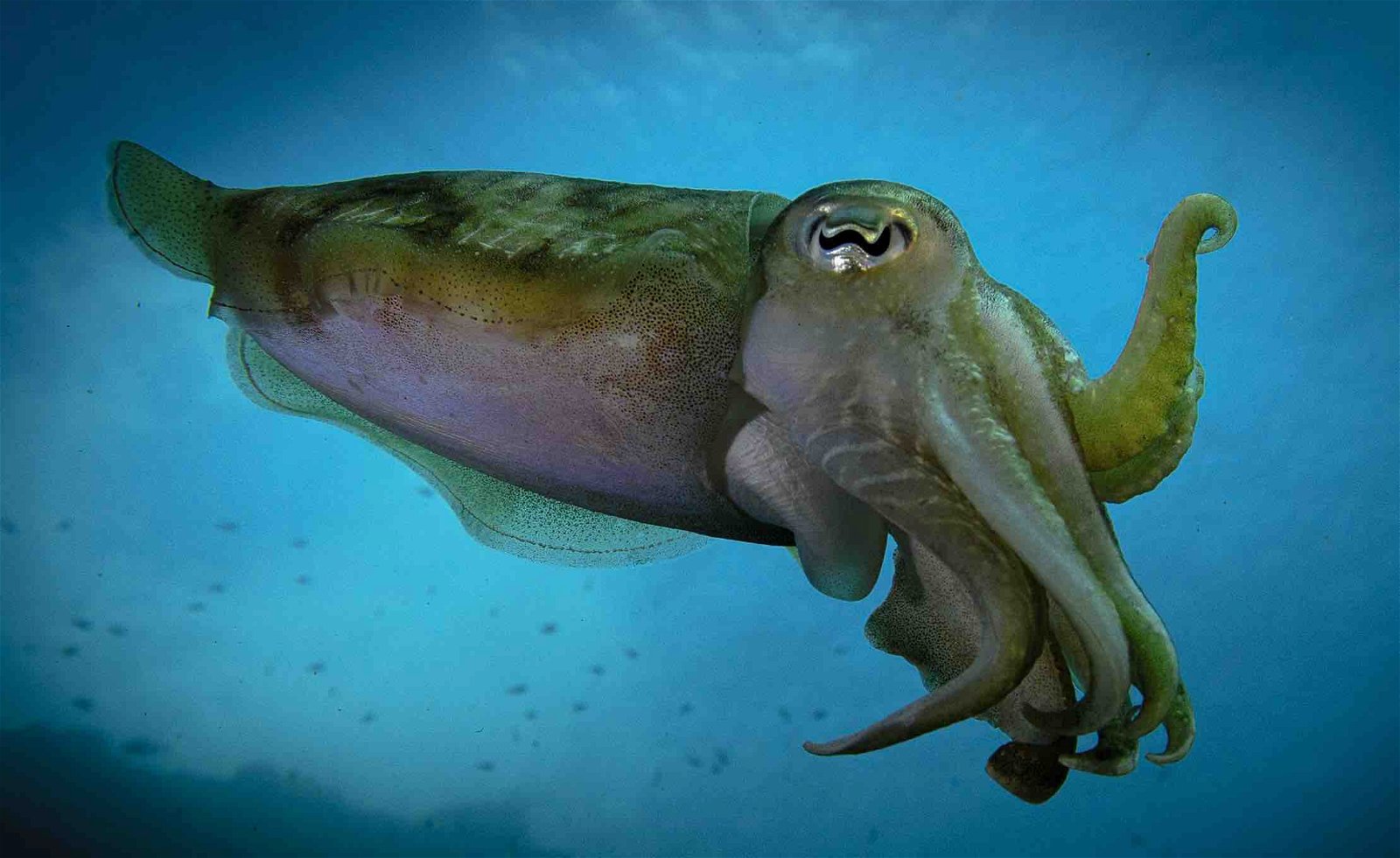Known for their vivid camouflage and high level of intelligence, cuttlefish continue to fascinate researchers, and according to new findings from the University of Tokyo, Aquarium Asamushi, and Tokai University, these colorblind mollusks are using their ink to create a dark backdrop for their colorful mating dances.
This use of ink contradicts previous ideas about cuttlefish behavior, as experts believed it was only used as a defense mechanism, creating a “smoke screen” that provides the creatures enough time to flee from predators.
The Complications of Courtship
Like many other animals, cuttlefish have a complicated mating ritual where the males often work to impress their prospective female mates with a brilliant and flamboyant display of colors across their bodies.
“In just about all species, the male approach females and try to impress them with a series of color changes which can also be associated with various postures and movement,” says Dr. Culum Brown, a professor at Macquarie University in Australia not involved with this study. “Many visual displays involve pulsating or otherwise striking changes in color. Considering these animals are just supercharged snails, their displays are amazing to watch.”
However, many of these displays also include a touching aspect beyond just the visual appeal.
“There is also chemotactile signaling, in which information can be exchanged through touch with their highly sensitive arms,” explains Theodora Mautz, a graduate student at the Scripps Institution of Oceanography at UC San Diego, who was not affiliated with this study.
Adding the tactile part of the mating ritual allows females to get a better picture of their potential suitor, especially since cuttlefish, along with other cephalopods like octopuses and squids, are technically colorblind.
The Challenge of Colorblindness
Unlike the human eye, the cuttlefish eye only contains one color-sensitive protein, reducing the cephalopod’s vision to black and white. To compensate for this issue, cuttlefish and their cephalopod relatives often use a property known as “chromatic blur” to detect other types of colors.
Chromatic blur works when the lens of the cuttlefish’s eye rapidly shifts focus between different depths. During this process, some wavelengths of light bend the cuttlefish’s eye lens more than others, allowing the fish to “detect” certain wavelengths, or colors, of light based on how they blur. This is especially helpful for survival processes like camouflage from predators or creating a successful mating display.
Cuttlefish Promiscuity
Because females are often picky when it comes to mating rituals, many male cuttlefish tend to get creative.
In many instances, the male cuttlefish’s colorful display splits down his body lengthwise, where just one side facing the female will pulse with a variation of pigments. The other side of his body remains a drabby brown color, often to make him appear like a female, tricking other potential suitors into mating with him and not his desired target.


“Many cephalopod species are polyandrous (females mate with multiple males) and the females can store sperm for a long time before fertilizing their eggs,” says Mautz. “However, we still understand very little of how and why they do so.”
It also turns out that this sneaky behavior may be further exploited when the male cuttlefish uses ink in his mating display.
Using Ink for Mating
To better understand the nuances of cuttlefish mating, researchers from the Aquarium Asamushi, Tokai University and the University of Tokyo, captured 56 Sepia andreana, also known as Andrea cuttlefish (13 males and 43 females). From their time in captivity, the cuttlefish performed 36 mating rituals, which the researchers analyzed and published in Ecology and Evolution.
The researchers found that the cuttlefish performed two different types of mating rituals. In the first ritual, the males showcased brilliant pulsating colors across their bodies, combining this biological light show with touching from their longer set of tentacles. If the female was impressed with the male, she would mate with him immediately after the ritual.
In the second type of mating ritual, the male uses some of his ink to create a dark backdrop, which he then floats in front of to contrast his bright colors better.
“The reason why this paper is interesting is because it is the first reported use of ink in a mating display,” Brown adds. “It is yet more visual trickery serving to draw attention to the male and perhaps even manipulate the display background.”
The researchers also found that the ink display helped the male cuttlefish hide the female from competitor males, ensuring a more successful mating ritual for her current suitor.
However, Brown also believes using ink for mating could be a more accurate measurement of physical health.
He adds that “producing ink is a very expensive thing for these animals to do, so perhaps only the best males can afford to throw it around in displays like this. It might be an honest indicator of male fitness.”
While marine biologists are still digging into the full implications of these findings, this research opens new avenues for other scientific inquiries into cephalopod communication, and evolution. By expanding our knowledge of how cephalopods use their environment to breed successfully, we can better appreciate the complexity of these marine creatures and the ecological roles they play.
Kenna Hughes-Castleberry is a writer and the Science Communicator at JILA (a partnership between the University of Colorado Boulder and NIST). She is also the co-host of The Debrief Weekly Report podcast. You can find more of her work at her website: https://kennacastleberry.com.

